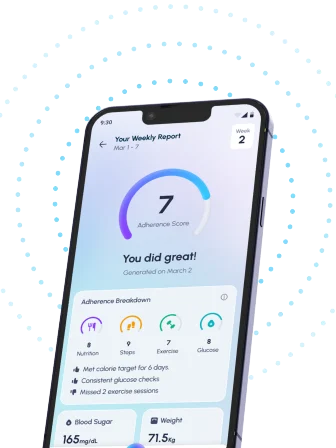Table of Contents
- Understanding the Diabetes-Oxygen Connection
- How Blood Sugar Impacts Oxygen Levels
- Managing Blood Sugar for Better Oxygenation
- Diabetes & Oxygen: A Comprehensive Guide
- Is There a Link Between High Blood Sugar and Low Oxygen?
- Frequently Asked Questions
- References
Managing diabetes is a daily balancing act, and understanding the intricacies of your body’s processes is key to successful control. Have you ever considered the connection between your blood sugar levels and your body’s oxygen utilization? In this post, we’ll delve into Diabetes & Oxygen: Exploring the Blood Sugar Connection, uncovering how effectively your body uses oxygen can be impacted by diabetes and how this impact, in turn, can affect your overall health. We’ll explore the science behind this often-overlooked relationship and offer practical insights to help you better manage your condition. Let’s unravel this fascinating link and empower you with more knowledge to navigate your diabetes journey.
Understanding the Diabetes-Oxygen Connection
High blood sugar, a hallmark of diabetes, impacts the body’s ability to utilize oxygen efficiently. This connection is crucial, particularly in hot and humid climates prevalent in many Indian and tropical countries, where oxygen demand can already be higher due to increased metabolic rate. Poorly managed diabetes can lead to various complications that further impair oxygen delivery and utilization.
The Role of Circulation and Oxygen Delivery
One key aspect is circulation. Diabetes can damage blood vessels, leading to reduced blood flow. This means less oxygenated blood reaches vital organs, contributing to complications like diabetic neuropathy (nerve damage) and cardiovascular issues. The reduced oxygen supply can exacerbate existing conditions and trigger further health problems. For individuals in tropical regions, where heat can already strain the cardiovascular system, this reduced oxygen delivery can be particularly dangerous. This is further explained in our article on How Does Diabetes Affect Blood Flow?.
Impact on Organ Function
The impact extends beyond circulation. Nearly 30% of people with diabetes develop diabetic nephropathy, a serious kidney disease. Damaged kidneys struggle to filter waste products and maintain proper fluid balance, affecting oxygen levels in the blood. This condition, coupled with the heat and humidity common in many tropical climates, puts individuals at significantly increased risk for dehydration and organ damage. The link between diabetes and other health complications, such as obesity, is also significant. For more information, see our blog on Understanding the Link Between Diabetes and Obesity.
Practical Steps for Better Oxygen Utilization
Managing blood sugar levels is paramount. Adopting a healthy diet rich in fruits and vegetables, regular physical activity, and adherence to prescribed medication are crucial for maintaining good blood sugar control and supporting better oxygen utilization. Staying hydrated is also essential, especially in hot and humid regions, as dehydration can worsen the impact of reduced oxygen delivery. Regular check-ups with your doctor and monitoring of vital signs are highly recommended. Prioritizing blood glucose management will significantly improve your body’s ability to utilize oxygen, particularly important in the context of tropical climates.
How Blood Sugar Impacts Oxygen Levels
Maintaining healthy blood sugar levels is crucial, especially in hot and humid climates common to many Indian and tropical countries. High blood sugar, or hyperglycemia, a hallmark of diabetes, significantly impacts how your body uses oxygen. This impact is multifaceted and can exacerbate existing health conditions.
The Oxygen-Glucose Connection
Glucose, the primary sugar in our blood, requires oxygen for its metabolism. When blood sugar levels are consistently high, your cells need more oxygen to process the excess glucose. This increased demand can strain your cardiovascular system, especially in individuals already at risk. For example, studies show that smokers with diabetes face a doubled mortality rate due to cardiovascular complications. This highlights the critical link between blood sugar control, oxygen utilization, and overall health outcomes. Managing diabetes effectively becomes even more vital in warmer climates where the body naturally works harder, increasing the metabolic demands and oxygen needs.
Practical Implications for Tropical Regions
In regions like India, where diabetes prevalence is high, understanding this connection is paramount. High temperatures and humidity can further stress the body, increasing the demand for oxygen and potentially leading to complications for individuals with poorly managed diabetes. Prioritizing regular blood sugar monitoring, maintaining a healthy diet emphasizing fresh fruits and vegetables readily available in these regions, and staying hydrated are crucial steps. Regular exercise, adapted to suit the climate, is also vital for improving oxygen utilization and overall well-being. Consulting with a healthcare professional to create a personalized diabetes management plan tailored to your specific needs and environment is strongly recommended. Taking proactive steps to manage your blood sugar can help ensure your body has the oxygen it needs to function optimally, reducing the risk of serious complications. For more information on maintaining healthy blood sugar levels, see our article on Blood Sugar Levels. Understanding why blood sugar might spike in the morning can also be helpful, so check out our guide on Why Blood Sugar Spikes in the Morning and How to Manage Them.
Managing Blood Sugar for Better Oxygenation
Maintaining healthy blood sugar levels is crucial for overall well-being, especially in individuals with diabetes prevalent in Indian and tropical countries. Poorly managed diabetes can significantly impact oxygenation, leading to various complications. This is because high blood sugar damages blood vessels, reducing their ability to efficiently carry oxygen throughout the body. Hyperglycemia, or high blood glucose, can also thicken the blood, further hindering oxygen transport.
Understanding the Blood Sugar-Oxygen Connection
For people with diabetes, maintaining blood pressure and blood sugar within healthy ranges is paramount. The ideal blood pressure target is generally below 140/90 mmHg, although some guidelines recommend aiming for below 130/80 mmHg. Achieving and maintaining these levels directly impacts oxygen delivery. When blood pressure is controlled, the heart doesn’t have to work as hard, improving circulation and oxygen flow. Similarly, controlling blood sugar prevents the thickening and damage to blood vessels, ensuring optimal oxygen transport to tissues and organs.
Practical Steps for Better Oxygenation
In hot and humid climates common in many Indian and tropical regions, staying hydrated is crucial for maintaining blood flow and oxygenation. Regular exercise, even short walks, helps improve circulation. A balanced diet rich in fruits, vegetables, and whole grains is essential for stable blood sugar levels. Regular monitoring of blood sugar and blood pressure is critical for early detection of any abnormalities. Consulting with a doctor or a certified diabetes educator is crucial for personalized guidance and management strategies. Seek professional medical advice to tailor your diabetes management plan to your specific needs and the climate you live in. For additional tips on managing blood sugar, especially during colder months, you might find Winter Tips for Managing Blood Sugar Levels helpful. This is especially relevant as seasonal changes can impact blood sugar control, and the advice provided in Winter Tips for Controlling Blood Sugar Levels can be beneficial year-round.
Diabetes & Oxygen: A Comprehensive Guide
Diabetes significantly impacts oxygen utilization in the body. This is particularly crucial in hot and humid climates prevalent across many Indian and tropical countries, where the body already works harder to regulate temperature. A staggering 61% of people with diabetes are aged between 20-64 years, a crucial demographic for economic productivity and overall health, highlighting the widespread impact of this condition. Understanding this connection is vital for better management and prevention of complications.
The Impact of High Blood Sugar on Oxygen
High blood sugar levels, a hallmark of diabetes, can impair the body’s ability to use oxygen efficiently. This is because high glucose levels can damage blood vessels, reducing blood flow and oxygen delivery to tissues. This can lead to various complications, including slow-healing wounds, which are particularly problematic in warm, humid climates where infection risk is higher. Individuals with diabetes in tropical regions may experience more severe consequences due to pre-existing health challenges exacerbated by the climate.
Managing Diabetes in Tropical Climates
Effective diabetes management in Indian and tropical countries requires a multifaceted approach. Maintaining optimal blood sugar levels through diet and medication is crucial. Regular exercise is equally important but requires careful consideration of the climate. Staying hydrated is also crucial to prevent dehydration, which can further impact oxygen delivery. Regular check-ups with healthcare professionals are essential for early detection and management of complications. Furthermore, focusing on a diet rich in fresh produce and managing stress levels can significantly improve overall health outcomes. As you age, the challenges of managing diabetes can increase; for insights and solutions, refer to our guide on Managing Diabetes as You Age: Challenges and Solutions.
Taking Control of Your Health
Living with diabetes in a tropical climate presents unique challenges, but with proper awareness, management, and proactive healthcare, individuals can lead fulfilling and healthy lives. Consult your doctor to discuss tailored strategies for managing your diabetes effectively within your specific climate and lifestyle. Early intervention and proactive management are key to mitigating the long-term effects of diabetes. Remember, knowledge is power – empower yourself with understanding and take control of your health today. If you’re planning any travel, be sure to check out our tips on Traveling with Diabetes: Essential Tips for a Safe & Healthy Journey to ensure a smooth and healthy trip.
Is There a Link Between High Blood Sugar and Low Oxygen?
The relationship between blood sugar levels and oxygen saturation is complex, particularly relevant in regions like India and other tropical countries where diabetes prevalence is high. Studies show a concerning statistic: HbA1c levels above 9% are reported in over 30% of diabetes patients. This indicates poor blood sugar control, which can have significant implications for oxygen utilization at a cellular level.
Understanding the Connection
High blood sugar, or hyperglycemia, can damage blood vessels over time. This damage affects the efficient delivery of oxygen throughout the body. Damaged capillaries, the smallest blood vessels, become less permeable, hindering oxygen diffusion from the bloodstream to tissues. Consequently, this reduced oxygen supply can lead to various complications, particularly in organs like the heart, kidneys, and eyes – problems prevalent in many tropical climates. Furthermore, chronic hyperglycemia can contribute to inflammation, further impairing oxygen delivery. This is especially crucial in hot and humid environments where the body already works harder to regulate its temperature.
Regional Considerations
In India and other tropical countries, factors like lifestyle, diet, and genetic predispositions contribute to higher diabetes rates. The combination of these factors with impaired oxygen delivery due to high blood sugar can exacerbate existing health issues. For example, individuals may experience increased fatigue, shortness of breath, and reduced physical stamina, impacting their quality of life. Regular monitoring of blood glucose levels and HbA1c is crucial for early detection and management of potential complications. Maintaining healthy blood sugar levels is also important for managing weight, as explained in our article on Weight Loss and Blood Sugar Levels: Simple Connection Explained.
Taking Action
Maintaining healthy blood sugar levels is paramount to ensuring adequate oxygenation. This involves a balanced diet, regular exercise, and adherence to prescribed medication. Consult your physician or a qualified healthcare professional for personalized advice and management strategies tailored to your specific needs and regional context. Early intervention is key to preventing serious long-term complications associated with both high blood sugar and reduced oxygen levels. It’s also important to note that other health conditions, such as Low Blood Pressure, can impact oxygen delivery and overall health.
Frequently Asked Questions
Q1. How does high blood sugar affect the body’s use of oxygen?
High blood sugar damages blood vessels, reducing blood flow and the delivery of oxygen to vital organs. This is especially problematic in hot, humid climates, where the body’s metabolic demand for oxygen is already increased.
Q2. What are the potential complications of poor blood sugar control in hot climates?
In hot and humid conditions, the combination of reduced oxygen delivery due to damaged blood vessels and increased metabolic demand significantly raises the risk of dehydration and organ damage, potentially leading to complications like neuropathy and nephropathy.
Q3. How can I manage my blood sugar effectively in hot weather?
Effective management involves maintaining healthy blood sugar levels through diet, exercise, and medication; staying well-hydrated; and regularly monitoring your blood sugar and blood pressure. Regular check-ups with your doctor are crucial for personalized management.
Q4. Why are regular check-ups with a healthcare professional important for managing diabetes?
Regular check-ups allow for early detection of complications and enable healthcare professionals to develop personalized management strategies that consider your individual needs and the climate you live in.
Q5. What is the most important factor in preventing serious complications from diabetes?
Prioritizing blood glucose control is essential for optimal oxygen utilization and preventing serious complications associated with reduced blood flow and oxygen delivery to vital organs.
References
- A Practical Guide to Integrated Type 2 Diabetes Care: https://www.hse.ie/eng/services/list/2/primarycare/east-coast-diabetes-service/management-of-type-2-diabetes/diabetes-and-pregnancy/icgp-guide-to-integrated-type-2.pdf
- Children with Diabetes : A resourse guide for families and school. : https://www.health.ny.gov/publications/0944.pdf




